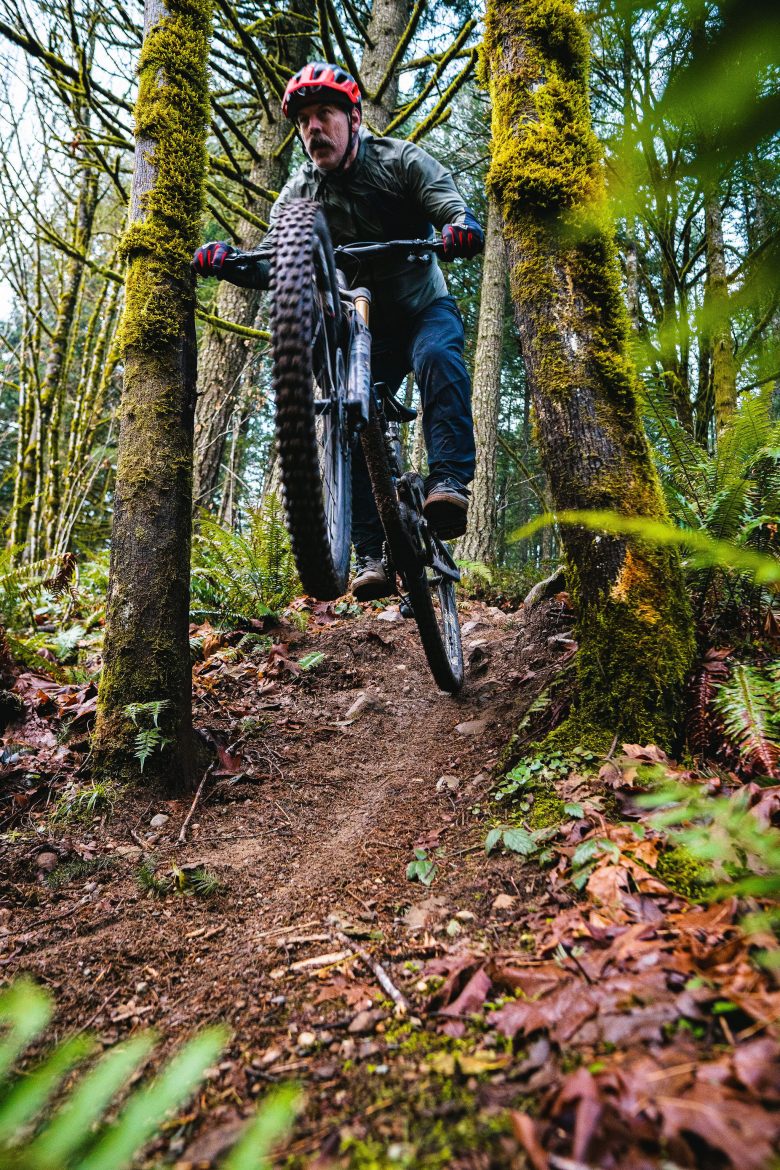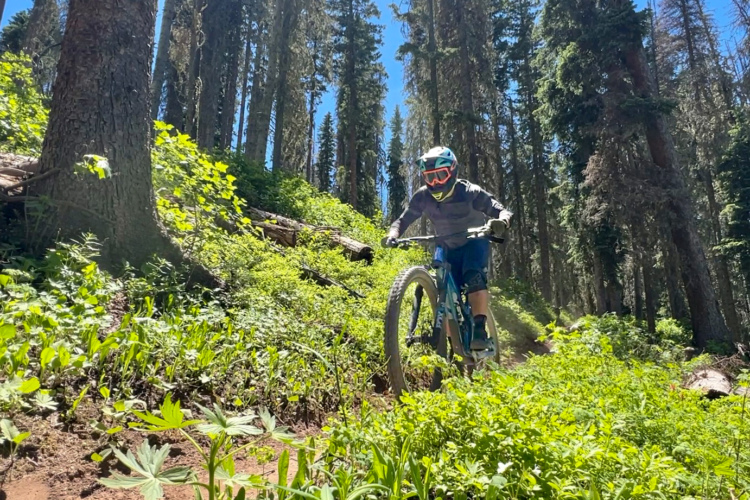
Whether it’s the Cadillac Trail, Redbug, or Munson Hills, the local trails I ride most often all have sections with narrow trees or other features. Even after years of riding, I still get nervous every time I approach tight sections of trails and I’ll even clip an obstacle on occasion.
I know most of my issues with tight trails are mental in nature, but they adversely affect my on-bike performance and increase the chance of error. I was curious to see if there were any tips for riding tight trails I could employ to make myself more comfortable doing it.
I turned to Jason Gainey at Fluidride for advice. Gainey was a childhood BMX racer and later a BMX dirt jumper. He picked up mountain biking at age 39 and soon started racing enduro. Gainey podiumed in the Pro class as well as winning overall series championships in the 40+ Masters class at the Cascadia Dirt Cup and Montana Enduro series.
Gainey is a professional coach and guide as well as a volunteer coach for middle school and high school mountain bike teams in his home state of Washington. He is no stranger to riding tight trails so he gladly shared some excellent tips.
Finding the right handlebar width
Not that long ago, handlebars more than 700mm wide were few and far between. Today, it’s hard to find handlebars narrower than 700mm. While those “yard bars” look cool on trail bikes, they might hang riders up on tight trails. Gainey has some advice when it comes to handlebar width.
“I always recommend taking the time to cut your bars down if you allow any grip to show outside your hand. Our bodies do an amazing job knowing where we are at. If you get a bike with low cranks then you will initially clip your pedals (on roots or rocks) often, but, as you get used to the bike, it happens less and less.” Gainey refers to that as unconscious awareness. “If you ride in an area with tight, tall rocks or trees then I recommend taking the time to find your correct bar width.”

To find the correct width, riders should start with an older pair of handlebars they won’t mind throwing away if they cut them too narrow. Gainey then recommends slowly cutting the bars narrower and narrower, in 5mm increments. “I’ll do at least 4 rides on a width, then go another 5mm.”
According to Gainey, there will be a point that after four rides the handlebars will feel too narrow. “That is when you know the best width for your strength-to-maneuverability range is the previous width. Then I cut a fresh set of handlebars to the last comfortable width. This allows you to have your hands at the outside edge of grips.”
Once on the trail, pick a side then look past the tight section
Though it might seem counterintuitive, Gainey suggests favoring one side of the trail if a rider wants to make it through a tight section without incident. “When it comes to trees or obstacles on both sides of trails, I choose to pick a side to stay close too. This allows [you to] control awareness of the obstacle.” When riding on trails where one side drops off, Gainey favors riding away from the drop off. “This is because it gives me more space if the bike side steps at all on the off camber. Additionally, if I clip the tree then it will send me towards the uphill side of the bank rather than sending me to the downhill side.” After all, clipping a tree can suck but falling off a cliff is even worse.
Where a rider looks is also important. “I look past the trees and continue to look as far down the trail as possible. The old ski saying if you look at the trees you will head right for them is true. Don’t look at what you might hit, rather look past that to where you want to go.”
Speed and body position are also key factors when riding tight trails
Gainey emphasizes the importance of having the correct speed and body position when riding tight trails. “I maintain a speed that allows me to focus on forward motion rather than side to side. In terms of balance, I ride with my core weight in my feet and have loose arms. This is very important because if I clip an obstacle and my arms are passive then the bars will turn and straighten and I can continue down the trail. The same thing that happens if your tire hits an obstacle and the bars get jerked in a direction. When you have tension in your arms it will pull you off line, but with passive arms your core body will continue forward and the arms will allow the movement to happen and then return.”
Good body position for off-camber situations is also important. “It’s important to remember that a flat turn body position will help maintain the high side of the trail. Your core should be turned slightly uphill. This is allowed by the hips shifting out slightly towards the downhill side of trail. Maintaining that body position adds weight and traction to the corner knobs that are actually more in contact with the ground, helping to carry momentum across the trail rather than being carried down.”
For advanced riders, Gainey suggests doing light manuals and turning the handlebars about 45 degrees to create a narrower width to help squeeze through the tightest of spots if the terrain allows it.
Clipping obstacles may be inevitable
Riders can do all the things Gainey mentioned above and still clip an obstacle on a tight trail. “Here in the Northwest, clipping trees is almost a right of passage as you get into more advanced trails.” But they shouldn’t get tense when they ride through tight sections of trail. “Stay loose, have your eyes up looking as far down the trail as possible, and focus on carrying momentum and being passive in the arms. Allow your elbows to drop slightly as well to make a little extra room as you pass the obstacle. Being able to stay loose and carry your momentum forward if you do clip a tree is possibly the most valuable part of riding this terrain.”























3 Comments
Dec 30, 2021
Feb 13, 2022
Jan 1, 2022
There are exceptions.